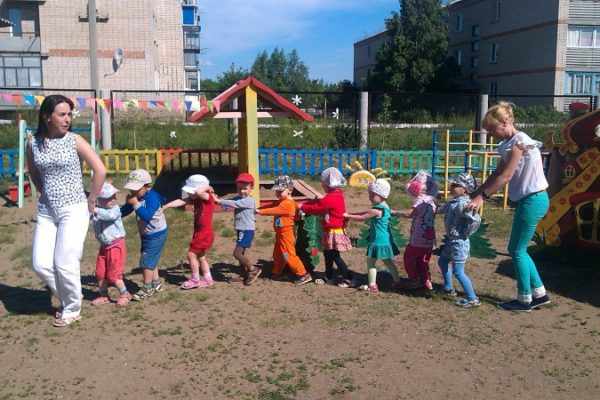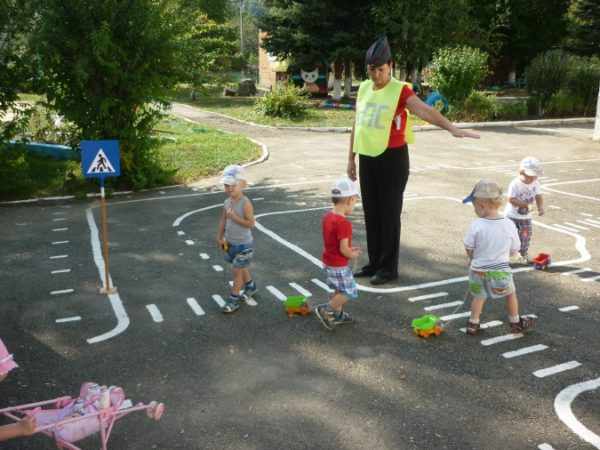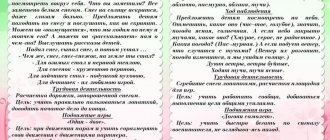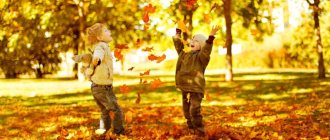Preparatory stage
Going outside begins long before the walk itself, as children and adults have to go through several important stages of preparation.
- Children blow their noses and go to the toilet.
- The teacher equips the first part of the children: checks that shoes and clothes are fastened correctly and helps those who are not yet completely able to dress themselves.
- Children go outside with a teacher.
- The assistant teacher helps the second group of children carry out hygiene procedures, dresses them and sends them outside to the first group.
- Returning from the street follows the same principle. Only children with poor health enter first, even though they always leave second.
Why are walks needed?
For kindergarten students, outdoor leisure is an effective way to experience the beauty and uniqueness of the surrounding nature and improve their health . These factors determined the inclusion of walks in the compulsory educational program of kindergartens.
Goals
Preserving and strengthening the health of children is the main goal of the educational process in preschool institutions. Outdoor leisure allows children to adapt to environmental conditions. At the same time, like any other type of work with children, the walk has 3 goal-setting directions: educational, educational and developmental. Based on this, the Federal State Educational Standard defines the following goals for outdoor exercise for children of the first junior group:
- mastering the norms of nature-conforming behavior (through observations of weather conditions, changing seasons, etc.),
- getting an idea of professions, types of animals, plants, etc.,
- development of analysis skills, assessment of changes in the surrounding nature and the formation of the skill to record these transformations using oral descriptions.
Knowledge of the surrounding world occurs through direct interaction with it
Tasks
To achieve the set goals, the teacher, planning combinations of activities during a walk, lays down a number of educational tasks:
- Demonstration of the perfection of everything created by nature: blades of grass, spider bugs, etc.
- Acquaintance with different seasons, interesting sights in one’s native area, and the work activities of adults (for example, builders, janitors, etc.).
- Working to improve the culture of health. For the first younger group, this is the ability to put on and take off outer clothing without (or almost without) the help of adults, putting on shoes, developing the skill of washing hands, communicating the need to go to the toilet, blowing your nose before and after a walk.
- Fostering a positive, respectful attitude towards people and nature.
Organization rules
In order for leisure time on the street to work to accomplish the assigned tasks, it must be properly organized.
- The most important condition is that the site meets sanitary standards: cleanliness, absence of objects that threaten health.
- Sandbox, swings, ladders, slide, gazebo for rainy weather, etc., rationally placed on the territory.

Despite the presence of different equipment on the site, there should be enough free space for games
- Equipment for active and relaxing games. Methodists recommend making 1-2 sets of toys, figures, and play equipment for 2 weeks. Such kits help clarify and concretize children’s knowledge. For example, fruit and vegetable toys to determine what grows in the garden and what is in the garden, or wild and domestic animals to teach kids to determine who lives on a farm and who lives in the forest. They also take buckets, scoops, baskets for work activities, balls of different sizes, etc. for walks.
This is interesting. Detailed information on sanitary standards is presented in SanPiN dated May 15, 2013 No. 26 ABOUT APPROVAL OF SANPIN 2.4.1.3049–13 “Sanitary and epidemiological requirements for the design, content and organization of work in preschool organizations.”
Types of walks
Based on the timing of the daily walks, they are divided into:
- morning - before lunch,
- evening - after a nap.
They are held at any time of the year under suitable weather conditions. In the first junior group, a walk in the cold season takes 4 hours, divided into 2 sessions. Summer work with children in kindergarten is called health-improving, since the weather conditions are favorable for improving children's health. During this period, all activities are carried out in the fresh air; children only eat and sleep indoors.
In terms of content, outdoor leisure can be organized in the following forms:
- Traditional, including children’s work activities, active and quiet games, etc.
- Sports leisure, that is, physical activity in the fresh air. Conducted 3–4 times a week. However, without a competitive element for children under 2–2.5 years old, since kids at this age do not understand it.
- Targeted exits outside the kindergarten, for a short distance. These walks have the purpose of observing environmental phenomena and social events. On average, such events are organized 3–5 times a month.
- Unconventional walks. Some sources identify such leisure as a separate type. Its implementation involves creating an unusual situation, for example, a walk and communication with a fairy-tale character. Such a Bunny, Teddy Bear, or Lion Cub can come to the site in order to talk about the signs of winter (autumn, spring). And then ask the guys questions about this material. Or organizing a kind of quest with riddles on a particular topic. These walks require careful design, for example, dressing the teacher in the costume of some character. Since, in essence, non-traditional walks are close to the target ones, in some methodological sources they are not distinguished as an independent type.

Toy cars and strollers can be used to play while learning about traffic rules.
MAGAZINE Preschooler.RF
Summary of a thematic walk in the junior group “Journey through Fairy Tales”Completed by: teacher: Arkhipova Svetlana Yuryevna MBDOU “kindergarten No. 44”, Ussuriysk 2022
Walk Passport
Type of walk: thematic.
Type of walk: group.
Implementation timeframe: short-term - urgent (one day).
Participants of the walk: children of the younger group, teacher, fairy-tale character Grandma - Rasskazushka.
Target audience: 3-4 years
Venue: kindergarten site.
Form of conduct: gaming.
Educational field “Social and communicative development”
Integration with other educational areas:
- "Cognitive"
- "Speech development"
- "Physical development"
Goal: creating favorable conditions for the development of a fairy tale plot by combining individual actions into a single storyline.
formation and development of play actions, cognitive abilities of children.
Tasks:
Educational:
- introduce children to fairy tales;
- develop the skills of playing together while walking;
- to develop the skills of role-playing behavior - the simplest game interaction, understanding the conventions of the game situation;
- enrich children’s gaming experience through joint participation in different games: active, didactic, story-based;
- enrich the experience and knowledge of children, expand their understanding of the environment;
- develop basic mathematical abilities in counting within «3»,
- consolidate knowledge of geometric shapes (circle, square, triangle), colors (yellow, red, blue).
- Expand knowledge about vegetables, the profession of a cook, and preparing vegetable soup.
Educational:
- develop and direct cognitive interest in fairy tales;
- activate mental activity, develop memory and speech;
- develop observation and imagination;
- develop the ability to coordinate your actions with the actions of other children in the game; develop agility, speed of movement, spatial orientation, practice high jumps, walking along a narrow path one after another;
- guide personal development.
Educational:
- bring up:
- an active love of fairy tales;
- The desire to participate in the development of a fairy tale plot, the desire to help fairy-tale characters find their fairy tale.
- cultivate sociability, responsiveness, friendliness;
- friendly relationships between children and the fairy-tale character Grandma Rasskazushka;
- enrich the child’s soul with beauty and bright feelings.
Resource provision:
- small sculptures to decorate the area;
- cardboard flowers;
- linoleum path;
- rope;
- toy: stove, saucepan (large), frying pan, spoon, knives, cutting boards, cups, spoons, ladle, tray;
- a jar of water, a plastic bottle with “vegetable oil” ;
- vegetables - dummies (consisting of several parts): potatoes, onions, carrots for each child;
- hats for the outdoor game “Geese-geese” : mother goose, geese, wolf.
Walking progress:
Grandma Rasskushka comes to visit the children.
Hello guys, there's a problem! In our fairy-tale land, the fairy tales got mixed up, and the heroes fled from them. Help bring them back, each to their own fairy tale. Children, do you know fairy tales?
Children: Yes!
Grandmother Storyteller: Then you will definitely find the heroes of fairy tales. But first, solve the riddles. Makes riddles.
Although he was without arms and legs, he was able to escape from the house. The wolf and the hare and the bear could not keep up with him.
But the fox knows the deal - “Am” ate it. (Kolobok)
In the fairy tale, the trickster fox cleverly deceived the bunny, driving her away from the hut. The bunny cried day and night.
But in trouble one brave cockerel helped him. (Fox and hare)
author: Olga Kiseleva
She grew up in the garden. And they pulled in order: grandfather, grandmother, granddaughter, Bug - they couldn’t! - big thing!
The cat and mouse just arrived - they were able to pull it out right away! ( "Turnip" )
Grandma Rasskazushka: “Well done children, you guessed correctly. And here are the fairy tales. He takes out 3 books from the basket: “Turnip” , “Kolobok” , “The Fox and the Hare” . He opens it, looks through each book, and sadly says: “There are no fairy-tale characters in books! Or maybe they’re hiding here on your property?”
The teacher invites the children to help Grandma Rasskazushka find fairy-tale characters. The children, together with the teacher, walk around the site and meet Kolobok sitting on a stump. Grandma - The Storyteller joyfully says: “Here is Kolobok - the ruddy side has been found!” They go further and see a Cat on a tree. Grandmother - The Storyteller exclaims: “The Cat has been found!” . Then the Hare was seen. Grandmother - The Storyteller rejoices: “So the Hare has been found!” Thank you guys, you have found all the fairy-tale characters. He takes out books with fairy tales, opens them and makes sure that the heroes: Kolobok, Cat, Hare have appeared in fairy tales again. The storyteller praises the children for their help.
Teacher: “Guys, tell me which fairy tale
Sister Alyonushka's brother was taken away by the birds. They fly high. They look far away.
Children: “Geese are swans”
Let's guys play together with Grandma - Rasskazushka - the outdoor game "Geese - Geese" .
The game "Geese - Geese" .
Goal: to expand knowledge about geese birds. Imitate the behavior of birds.
Tasks:
educational: to consolidate the ability to act on a signal, coordinating your actions with the actions of other children.
developmental: practice running in a straight direction, with dodging; develop dexterity and speed of movement.
educational: cultivate friendly relationships in the game.
Preliminary work:
reading the fairy tale “Geese and Swans” , looking at illustrations,
memorizing nursery rhymes: “The White Goose” , “Kisonka - Murysenka was herding the goslings.” Introducing children to the rules of the game “Geese-geese” (Geese walk through the meadow, nibble grass, stretch and tilt their necks, when they fly, they spread their wings and raise their arms to the sides.).
Organization:
Mother goose hat for a teacher, geese hats for children, wolf hat.
On one side of the site the house in which the geese are located is indicated.
On the opposite side is Mother Goose.
On the side of the site is a den in which a wolf lives. The rest of the site is meadow.
(a child is selected to play the role of a wolf, the rest of the children are geese).
Progress of the game
Mother goose: Geese, geese! Children: Geese: Ha-ga-ga! Mother Goose: Do you want to eat? Geese: Yes, yes, yes!
Mother Goose: So fly.
Children: Geese: We can’t, the gray wolf under the mountain won’t let us go home!
Mother Goose: Well, fly as you want, just take care of your wings!
The geese, spreading their wings, fly, and the wolf tries to catch them.
At the request of the children, the game is repeated 2-3 times.
Grandmother - The Storyteller admires the flowers in the flowerbed: “Guys, what beautiful flowers grow in your flowerbed! Do you know what they are called?
Children: Yes.
The teacher asks the children to name the flowers. Children: “Asters, marigolds, zinnias .
Narrator: Well done. Guys, you know flowers. And in what fairy tale did the little squirrel Ryzhik grow an extraordinary flower, bright as the sun?
Children: “This is the fairy tale “Sunny” .
Grandmother - Story: “And in a magical land, amazingly beautiful flowers grow. Would you like me to show them to you?
Children: “Yes!”
Grandmother - Story: “Okay, there will be flowers for you. Close all your eyes and listen to magical music. A wonderful melody sounds (from the TV show “Visiting a Fairy Tale” ). At the end of the music, the children open their eyes.
Magic flowers “grew” on the site (Three flowers). Next to them stands a grandmother - Story! Teacher: Oh, yes, grandma - Story! Come on, guys, let's go to grandma, she will show us magic flowers. But to get there, you need to walk along a “narrow path” and then jump over a “stream” without getting your feet wet, because there is cold water in the stream.
Children walk along a “narrow path” . They jump over the “stream” and find themselves near wonderful flowers. They look at them together with the teacher.
Teacher: “Look, guys, flowers! Count how many there are?
Children: "Three" .
Teacher: “What color?”
Children: “Red, yellow, blue .
Teacher: “They are magical, you see a geometric shape in the middle of each flower. Guys, name the geometric shapes.
Children: “Circle, square, triangle .
Teacher: “Now we’ll play!” . (Hands out plane geometric shapes to the children: circle, square, triangle).
Explains the rules of the game: Give the flowers their geometric shape.
To a cheerful melody, children each approach their own flower (according to the geometric shape) and place the shape in the middle of the flower. Children and a teacher enter the veranda of the site.
Grandmother - Story: “Well done, we played with the flowers.
The children go to the veranda and sit down at the tables.
Grandmother - The story addresses the children: “Grandfather from the fairy tale “Turnip” asked me to give you vegetables.
Children: “Thank you”
Teacher: “Come on, children, let’s cook vegetable soup for grandma, she’s already hungry .
The teacher turns to the grandmother - Rasskazushka: “If you want, we will prepare vegetable soup for you .
Grandmother - Storyteller: “Yes, I love him very much!” .
The plot-role-playing game “Let’s make vegetable soup”
Story-role-playing game “Let’s make vegetable soup”
Educational field “Social and communicative development”
Target:
introduce the preparation of vegetable soup, create conditions for the development of the plot of the game. Expand knowledge about vegetables.
Tasks:
educational: expand knowledge about the beneficial properties of vegetables - you can prepare different dishes from them. Introduce the process of preparing vegetable soup; purpose of the stove, kitchen utensils: saucepan, frying pan, knife, cutting board, ladle, spoon, cups. Develop the ability to develop the plot of the game and fulfill your role.
developing: develop memory, thinking, imagination, speech.
educational: to cultivate friendships in the game, to evoke an emotional response to children preparing soup for their grandmother - Rasskazushki.
Activating vocabulary: vegetable soup. Activate generalizing words in speech: vegetables, dishes.
Enrichment of vocabulary: butter, nourishing, vitamin.
Material: toys: stove, saucepan (large), frying pan, spoon,
knife, cutting board, cups, jar of water. Vegetables - dummies (consisting of several parts): potatoes, onions, carrots for each child.
Progress:
Teacher: “Now, guys, we will cook vegetable soup for grandma. What is this soup called?
Children: "Vegetable" .
Children, what vegetables are needed for vegetable soup? Children list vegetables (potatoes, carrots, onions).
The teacher takes out the necessary vegetables from the grandmother’s basket. Children reinforce shape, color and size.
The teacher addresses the children: “Let’s imagine that you and I are in the kitchen. I will be the cook, and you are my assistants. We will cook the soup on a (toy) stove. We will need dishes. Shows all the items that will be needed to prepare vegetable soup. What are we going to cook the soup in?
Children: “In the pan”
The teacher takes the pan and puts it on the stove.
Teacher, the soup will be liquid, so you need water. Shows water in a jar. Water is a liquid, it is clean and transparent. Pour it into the pan. Turn on the stove and wait for the water to boil. Now you should wash the vegetables, because what are they?”
Children: "Dirty"
The teacher washes vegetables in a cup of water. Children name actions after the teacher.
Now I’ll peel the potatoes with a knife, then the carrots and onions. Children name actions after the teacher.
Vegetables are peeled. Now guys, help me cut the vegetables. What will we use to cut vegetables?
Children: . ”
The teacher gives each child one vegetable. Children cut vegetables with a knife.
The teacher asks the children to bring him chopped vegetables. Places potatoes and carrots in a pan. Teacher: “The soup is cooking. Guys, what are we going to use to fry the onions?”
Children: . ”
Teacher: “To do this, I’ll pour a little vegetable oil. The oil hisses: “Sh-sh-sh-sh . How does it sizzle? (sound pronunciation exercise).
She asks the children to bring her chopped onions.
To prevent the onion from burning, I will stir it. The onion was fried. Place the onion in the pan, stirring the vegetable soup. The soup is ready!
Teacher: “Guys, what kind of soup did we make?”
Children: “Vegetable, tasty, vitamin rich.”
The children and the teacher treat their grandmother, Rasskazushka, to soup, and she eats it. Thanks the children: “Thank you, children. You made a delicious, hearty soup.
I liked it! You know how to play cheerfully and friendly. But it's time for me to return to fairyland. Goodbye. Leaves.
Result (Reflection).
Teacher: “Guys, who came to us for a walk? In which fairy tales are the heroes lost? What fairy-tale characters have we found? What games did you play? What did you like?
BIBLIOGRAPHY
- N. E. Veraksy, T. S. Komarova, M., A. Vasilyeva Program “From birth to school” .
- N. E. Veraksy FGT in a preschool educational institution. Complex classes. Second junior group. Volgograd. Publishing house "Teacher" 2012.
- . E. R. Zheleznova “Fairy tales in classes on familiarization with the environment and social development of preschoolers . Preschool pedagogy No. 8. - p. 25-27.
- T. Poshtareva “The use of folk tales in the educational process . Preschool education No. 5. – p. 24-27.
- ON THE. Korotkov “Plot game of preschoolers” , Moscow: ed. "Linka-Press" , 260 pp., 2016
- I. V. Gurina Fairy tale “Sun” .
- L. I. Penzulaeva “Physical training in kindergarten” . Junior group. Mosaic - synthesis, M. 2010
- Olga Druzhkova “1000 funny riddles for children” LLC AST 2000.
- E.Ya. Stepanenkova “Collection of outdoor games” Mosaic - Synthesis M. 2011. N.A. Vinogradova, N.V. Pozdnyakova “Plot-role-playing games” M 2008.
- .P. G. Samorukova “How to introduce preschoolers to nature” (a manual for kindergarten teachers). Moscow. 1983.
- S.N. Nikolaev “Young Ecologist” System of work in the junior group of kindergarten. M. Mosaic - Synthesis. 2010.
| Next > |


